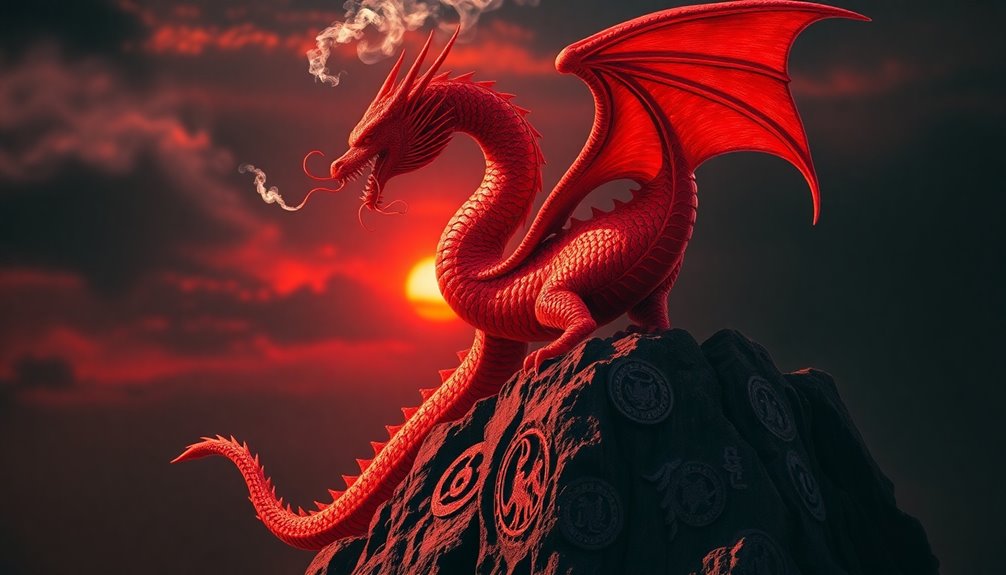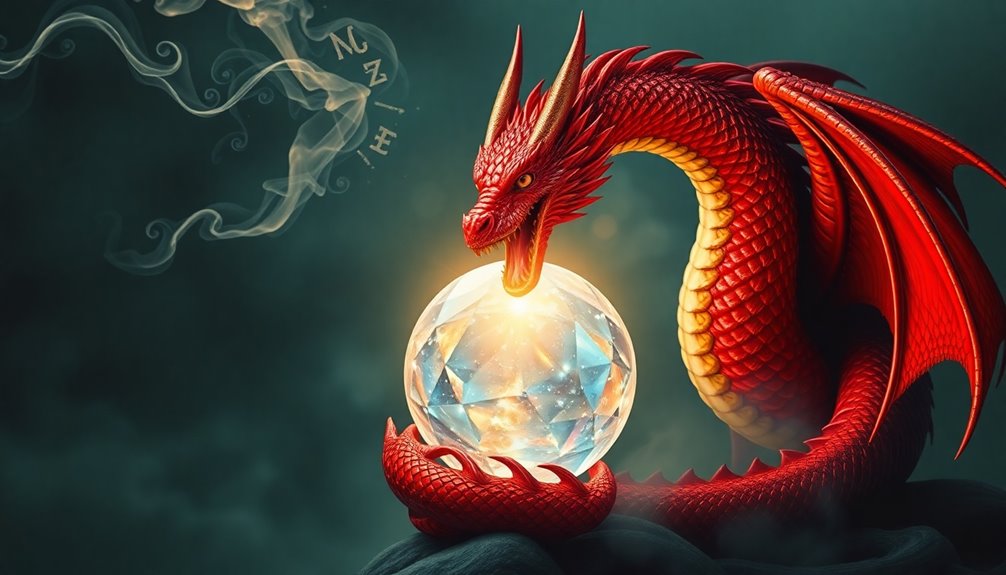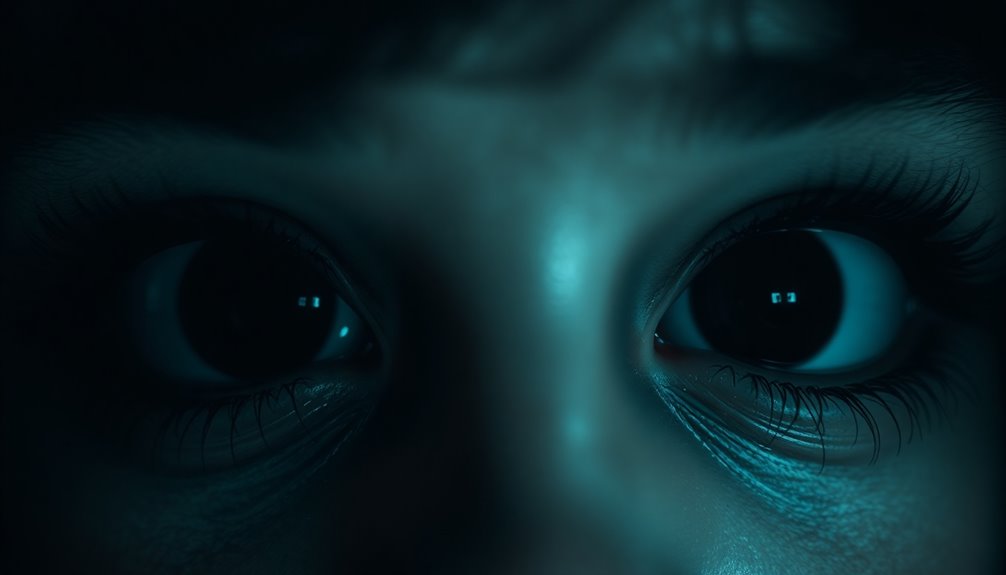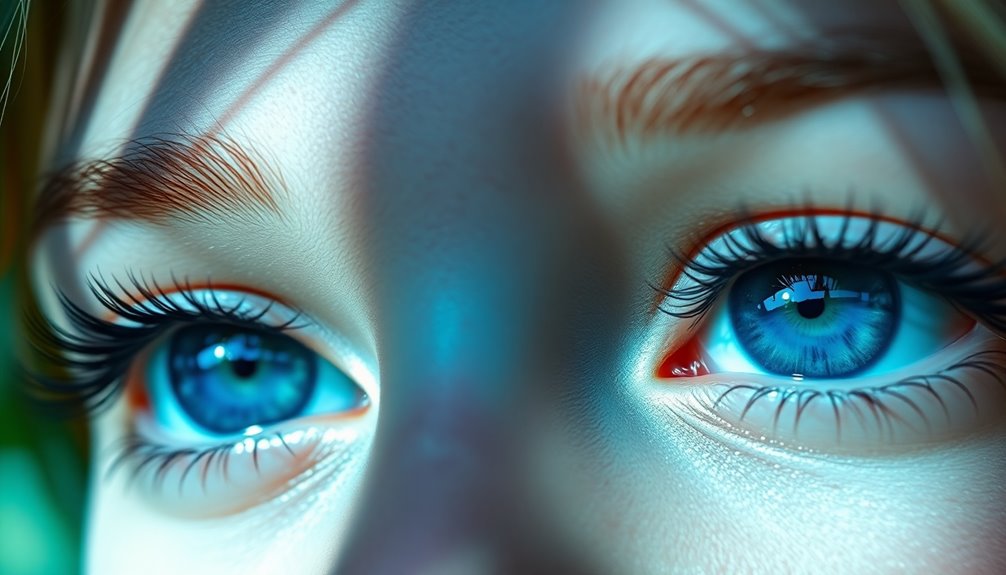A red dragon symbolizes powerful transformation, bridging the gap between chaos and creation. In Eastern cultures, it represents good fortune and prosperity, while in Celtic traditions, it embodies resilience and national pride. You'll find it portrayed in mythology as both a fierce adversary and a guardian of wisdom. The element of fire highlights its passionate nature, urging you to embrace inner strength and creativity for personal growth. This fiery emblem encourages you to see obstacles as chances for transformation. If you're curious about its rich symbolism and modern interpretations, there's much more to explore!
Key Takeaways
- Red dragons symbolize power and chaos in European mythology, often representing fierce challenges to heroes and embodying destruction and strength.
- In Eastern cultures, red dragons are revered as symbols of good fortune, prosperity, and imperial power, celebrated during significant events.
- The element of fire associated with red dragons signifies intense passion, creativity, and the duality of destruction and renewal in personal growth.
- Red dragons act as catalysts for transformation, encouraging individuals to embrace their inner strength and view obstacles as opportunities for self-discovery.
- In modern interpretations, red dragons represent personal empowerment and resilience, inspiring creativity and assertiveness in art, branding, and spiritual practices.
Cultural Significance of Red Dragons

Red dragons hold significant cultural meaning across various societies, often embodying powerful themes. In Eastern cultures, the red dragon symbolizes good fortune, luck, and prosperity, frequently linked to imperial power and celebrated during events like the Chinese New Year. You'll find that these mythical creatures are revered for their ability to bring blessings and happiness, reinforcing the idea of transformation in life.
In Celtic mythology, the red dragon represents national identity and resilience, capturing the spirit of the land and its cultural heritage. This connection emphasizes how the red dragon serves as a symbol of strength and unity.
Meanwhile, in European folklore, red dragons portray chaos and power, posing formidable challenges to heroes and knights, thereby underscoring the duality of their nature.
In American narratives, red dragons embody both creation and destruction, illustrating the complexities of life and human experience.
Today, you'll see these powerful icons in modern media and fantasy literature, where they continue to represent themes of mastery, courage, and transformation. The cultural significance of red dragons enriches our understanding of their role in storytelling and tradition across various societies.
Spiritual Meanings Across Traditions

In various spiritual traditions, the symbolism of the red dragon resonates deeply, often embodying the essence of transformation and personal empowerment. This ancient symbol transcends cultures, with each interpretation illuminating different aspects of its power.
In Asian cultures, the Red Dragon represents luck, prosperity, and wisdom, serving as a guardian figure that brings good fortune to those who honor it.
Celtic mythology also celebrates the Red Dragon as a national emblem of strength and resilience, reflecting the spirit of the land and the identity of its people. The duality of fire dragons, including the Red Dragon, indicates both creation and destruction, urging you to confront challenges and harness your inner strength for transformation.
Engaging with the energy of the Red Dragon in spiritual practices can greatly enhance your personal power. It inspires you to pursue your true destiny passionately while promoting mental well-being.
In Tarot, the Red Dragon appears in the 10 of Wands, reminding you to reflect on burdens and the importance of releasing unnecessary responsibilities for personal growth and fulfillment. Embracing these spiritual meanings can lead to profound empowerment and transformation in your life.
The Element of Fire and Passion

The element of fire embodies intense passion and creativity, igniting your life force with its primal energy. Red dragons, as symbols of this element, represent the fervor that drives you toward personal growth. Their fiery breath signifies both destruction and renewal, reminding you that embracing your inner fire can catalyze transformative power in your life.
When you connect with the energy of red dragons, you tap into a source of courage and determination. This connection encourages you to harness your passion and pursue your true destiny. Fire isn't just a force of chaos; it's a pathway to spiritual awakening.
By recognizing the dual nature of fire, you can learn to navigate challenges, using them as opportunities for growth and empowerment. As you embrace the passion that red dragons symbolize, you'll find that the transformative power of fire can lead to profound changes in your life.
Whether you're facing obstacles or seeking inspiration, channeling this inner fire will guide you on your journey. So, let the element of fire and the spirit of the red dragon fuel your ambitions and ignite your path to fulfillment.
Red Dragon in Mythology

Dragons have long captivated human imagination, especially in the domain of mythology where the red dragon stands out with its powerful symbolism. In European mythology, red dragons often embody chaos and destruction, acting as fierce adversaries in heroic tales, like the legendary battle between Saint George and the Dragon. Their mythical significance extends beyond mere villains; they represent the duality of power and the potential for transformation.
In Celtic mythology, the red dragon is a symbol of national identity, particularly in Wales, reflecting the spirit and resilience of its people in their struggle for independence.
Meanwhile, in Asian cultures, red dragons are revered as harbingers of good fortune, embodying prosperity and associated with the elemental power of fire. They often showcase their fire-breathing abilities, signifying strength and dominance.
In fantasy literature and games, red dragons are portrayed as greedy, powerful beings who hoard treasure, further emphasizing their majestic presence.
This complexity of red dragons highlights their role as both agents of chaos and symbols of transformation, reminding us of the intricate balance between destruction and renewal in our own lives.
Symbolism of Transformation and Change

The Red Dragon's symbolism of transformation encourages you to embrace your inner strength, pushing you to rise above challenges.
As a catalyst for personal growth, it sparks renewal and ignites your passions.
Embracing Inner Strength
Embracing your inner strength often feels like awakening a powerful force within, much like the fierce red dragon that symbolizes transformation and change.
These majestic beings embody the courage and determination you need to conquer personal challenges. When you tap into your inner strength, you channel the fiery nature of red dragons, igniting creativity and passion that fuel your journey of transformation.
Here are three ways to embrace your inner strength:
- Acknowledge Your Power: Recognize that you possess the personal power to shape your destiny. Just like the red dragon, you have the ability to rise from adversity.
- Embrace Change: Understand that transformation often requires you to step out of your comfort zone. Embrace each change as an opportunity for renewal and growth.
- Cultivate Resilience: Learn to bounce back from setbacks. The red dragon symbolizes resilience, reminding you that every challenge can become a stepping stone toward your goals.
Catalyst for Personal Growth
Throughout history, the red dragon has served as a powerful symbol of transformation and change, acting as a catalyst for personal growth. When you embrace the fiery nature of the Red Dragon, you tap into a wellspring of courage and resilience. This vibrant symbol inspires you to harness your inner strength, pushing you to confront challenges with determined intensity.
As you engage with the Red Dragon's energy, you'll likely feel a surge of empowerment, motivating you to pursue your goals passionately. The transformation you experience can be profound, as the dragon's fire represents burning away old patterns that no longer serve you. This process is essential for your rebirth and renewal, allowing for personal evolution.
The Red Dragon encourages you to view obstacles as opportunities, fostering a transformative journey toward self-discovery. By embracing this symbolism, you're reminded that growth often comes from facing adversity head-on.
Journey of Renewal
In the journey of renewal, the Red Dragon symbolizes the transformative power that lies within you, urging you to embrace change as a pathway to personal greatness. This fiery creature reflects your ability to harness inner strength and navigate life's challenges with resilience.
As you engage with the energy of the Red Dragon, you ignite your fiery passion for creative expression and growth.
Consider these key aspects of your journey:
- Embrace Change: Recognize that transformation is a natural part of life. Every ending opens the door to new beginnings, allowing you to evolve and flourish.
- Cultivate Inner Strength: Tap into your resilience. The Red Dragon inspires you to confront obstacles bravely, fostering a determination that paves the way for success.
- Express Creatively: Use your experiences as fuel for creative expression. The journey of renewal encourages you to channel your emotions into art, writing, or any form that resonates with your spirit.
Emotional Resilience and Inner Strength

The Red Dragon's fierce spirit embodies emotional resilience and inner strength, reminding you that you can confront life's challenges with courage and determination. This powerful creature symbolizes your capacity to overcome adversity, encouraging you to tap into your inner strength when faced with obstacles.
The Red Dragon's fiery breath represents an intense life force that ignites your creativity and passion, driving you toward personal growth.
As you navigate the tumultuous experiences of life, think of the Red Dragon as a guardian of your most valuable treasures—your dreams, hopes, and aspirations. Just like the dragon, your emotional resilience protects these aspects, enabling you to stand strong against chaos.
The fiery nature of the Red Dragon inspires transformation, urging you to embrace change and evolve through each challenge you encounter.
When you channel the Red Dragon's power, you cultivate an unwavering belief in your ability to rise above difficulties. Trust that your emotional resilience will guide you through dark times, fostering growth and helping you emerge stronger than before.
Incorporating nutritional support into your routine can further enhance your emotional resilience, providing you with the strength needed to face life's challenges head-on.
Embrace your inner strength and let the essence of the Red Dragon empower your journey.
The Role of Red Dragons in Art

Imagery of red dragons captivates artists and audiences alike, embodying a rich tapestry of symbolism that spans cultures and eras. In various art forms, red dragons symbolize power and transformation, often reflecting the duality of their nature as both protectors and adversaries.
- In Eastern art, red dragons are revered as auspicious symbols of good fortune and prosperity.
- Conversely, Western art often presents them as menacing figures, embodying chaos and greed.
- Both portrayals reveal deep cultural narratives, inviting you to investigate the complexities of these mythical creatures.
Artists use red dragon imagery to ignite your imagination and evoke strong emotional responses. Their vivid colors and dynamic forms serve as powerful metaphors for creativity and passion, as seen in the dragon's ability to breathe fire.
This symbolism allows you to explore themes of transformation and mastery, pushing the boundaries of your own creativity. Iconic representations in fantasy art and literature further solidify red dragons as symbols of adventure and epic journeys.
Ultimately, these majestic beings inspire a profound connection between art and the human experience, sparking your own journey of exploration and expression.
Modern Interpretations and Applications

Modern depictions of red dragons resonate powerfully with audiences, showcasing their evolution as symbols of strength and courage in various forms of media. In fantasy literature, video games, and films, red dragons often serve as formidable adversaries or heroic allies, embodying the essence of power and adventure. Their fiery nature reflects transformation, urging you to tap into your inner strength.
In contemporary culture, red dragons appear on merchandise and branding, representing liveliness and passion. This imagery resonates with consumers seeking personal empowerment and individuality. Many people choose red dragon tattoos to symbolize their journey of transformation and assert their personal power. These tattoos often draw from rich mythological traditions, merging past meanings with modern interpretations.
Furthermore, in spiritual practices, individuals harness the energy of red dragons to inspire creativity and assertiveness. By channeling this fiery symbol, you can overcome obstacles and embrace your passions, transforming challenges into opportunities.
Ultimately, red dragons remind you that embracing your inner fire can lead to profound personal growth and transformation, empowering you to pursue your goals with courage and determination.
Red Dragons in Tarot and Divination

Red dragons hold significant power in Tarot and divination, serving as potent symbols of strength and transformation. When you encounter fire dragons in your readings, they guide you through essential life lessons and illuminate your path toward spiritual growth. Their energy encourages you to harness your inner strength, helping you navigate challenges authentically.
Here are three key aspects of red dragons in Tarot and divination:
- Personal Fulfillment: In the 10 of Wands card, fire dragons represent the importance of reflection on burdens and the necessity of letting go of unnecessary responsibilities for true fulfillment.
- Inner Strength: Fire dragons embody strength and courage, guiding you in decision-making processes and encouraging you to confront life's trials with confidence.
- Transformative Journey: As powerful archetypes in Tarot spreads, red dragons symbolize enlightenment and the transformative journey of your soul, emphasizing the need for clarity and understanding of your inner struggles.
Embracing Your Inner Red Dragon

Harnessing the energy of a fire-breathing dragon can transform your life in profound ways. Embracing your inner Red Dragon means tapping into a reservoir of passion and energy that fuels your creative potential. This powerful symbol encourages you to pursue your goals with unwavering determination and courage, helping you face challenges with resilience.
When you align with the Red Dragon's energy, you open the door to spiritual awakening, inviting deeper self-reflection and the pursuit of your true destiny. It acts as a catalyst for transformation, reminding you that renewal is possible during times of change.
By channeling the fiery essence of the Red Dragon, you cultivate empowerment and assertiveness, enhancing your ability to navigate life's obstacles with confidence.
This journey isn't just about external achievements; it's also about inner growth. As you embrace your inner Red Dragon, you'll find yourself more equipped to confront fears and embrace the unknown.
Frequently Asked Questions
What Does the Red Dragon Symbolize?
The red dragon symbolizes strength, resilience, and passion.
When you think of the red dragon, you can envision a creature that embodies courage and an intense life force, igniting your creativity.
It's a representation of national identity in Celtic mythology and signifies good luck in Asian cultures.
Its fiery breath reminds you of power and destruction, while also guiding you toward personal transformation and empowerment, urging you to embrace your true destiny.
What Does the Red Dragon Symbolize in the Bible?
When you plunge into the Bible, you'll find the red dragon is a fierce, fiery beast, symbolizing chaos and destruction.
It's like the ultimate villain, representing Satan himself, lurking in the shadows with its seven heads and ten horns, ready to pounce.
This creature passionately pursues the Woman clothed with the sun, embodying the epic struggle between good and evil.
Ultimately, though, you'll see it's a defeated foe, showcasing the triumph of good!
What Does a Fire Dragon Symbolize?
A fire dragon symbolizes transformation, courage, and the duality of creation and destruction.
In various mythologies, you'll find that it represents the intense challenges you might face in life. Embracing this energy encourages you to pursue your passions wholeheartedly and fosters personal empowerment.
When you tap into the fire dragon's essence, you're not just overcoming obstacles; you're igniting your spirit and releasing your potential for growth and fulfillment.
What Does the Red Dragon Symbolize Spiritually?
When you're exploring the spiritual symbolism of the red dragon, you'll find it embodies passion and energy.
This vibrant creature pushes you to embrace your inner strength and courage. It inspires determination, urging you to transform challenges into opportunities for growth.
The red dragon's fiery essence ignites your creative energy, encouraging you to pursue your spiritual awakening.
Conclusion
Embrace the fierce power of the red dragon, a blazing symbol of transformation and passion. Picture it soaring through the skies, a fiery beacon against the cool, shadowy clouds of doubt. As you harness this energy, let it ignite your spirit and drive you toward change. Just as the dragon balances chaos and creation, you too can wield the flame of ambition, forging your path in the dance of life, where every flicker sparks new possibilities.











